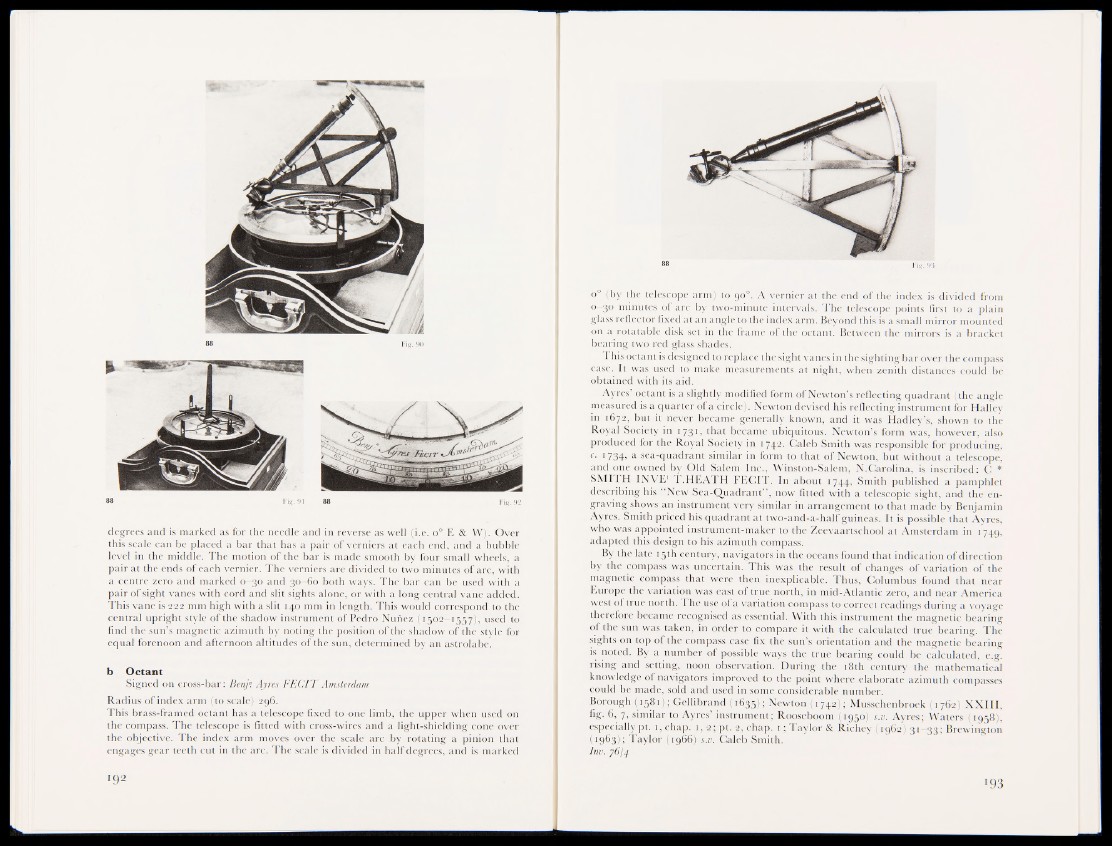
degrees and is marked as for the needle and in reverse as well (i.e. o# E & W). Over
this scale can be placed a bar that has a pair of verniers at each end, ,and a bubble
level in the middle. The motion of the bar is made smooth by four small wheel®; a
pair at the ends of each vernier. The verniers are divided to two minutes of arc, with
a centre zero and marked 0-30 and 30-60 both ways. The bar can be used with a
pair of sight vanes with cord and slit sights alone, or with a long central vane added.
This vane is 222 mm high with a slit 140 mm in length. This would correspond to the
central upright style of the shadow instrument of Pedro Nunez »502-155'*, used to
find the sun’s magnetic azimuth by noting the position of the shadow of the style for
equal forenoon and afternoon altitudes of the sun, determined by an astrolabe.
b Octant
Signed on cross-bar: Benjn. Ayres FECIT Amsterdam
Radius of index arm (to scale) 296.
This brass-framed octant has a telescope fixed to one limb, the upper when used on
the compass. The telescope is fitted with cross-wires and a light-shielding cone over
the objective. The index arm moves over the scale arc by rotating a pinion that
engages gear teeth cut in the arc. The scale is divided in half degrees, and is marked
o° (by the telescope armftto 90“. A vernier at the end of the index is divided from
0—30 minutes of arwlby two-minute intervals. The telescope points first to a plain
glass reflector fixed at an angle to the index arm. Beyond this is a small mirror mounted
on a rotatable disk set in the frame of the octant. Between the mirrors is a bracket
bearing two red glass shades.
I bis octant is designed to replace the sight vanes in the sighting bar over the compass
case. It was used to make measurements at nigh%-when zenith distances could be
obtained with Its aid.
Ayres octant is a slightly modified form of Newton’s reflecting quadrant (the angle
measured is a quarter of a circle). Newton|8fevised his reflecting instrument for Halley
in 1 6 7 , but it never became generally known, and it was Hadley’s, shown to the
Royal Society in 173E that became ubiquitous. Newton’s form was, however, also
produced for the Royal Society in 1742. Caleb Smith was responsible for producing,
tfl I734) a sea-quadrant similar in form to that of Newton, but without a telescope,
and one owned by Old Salem Inc., Winston-Salem, N.Carolina, is inscribed: C *
SMITH INVE‘ T.HEATH FECIT. In about 1744, Smith published a pamphlet
describing his New Sea-Quadrant” , now fitted with a telescopic sight, and the engraving
shows an instrument very similar in arrangement to that made by Benjamin
Ayres. Smith priced his quadrant at two-and-a-half guineas. It is possible that Ayres,
who was appointed instrument-maker to the Zeevaartschool at Amsterdam in 1749,
adapted this design to his azimuth compass.
By the late 15th century, navigators in the oceans found that indication of direction
by the compass was uncertain. This was the result of changes of variation of the
magnetic compass that were then inexplicable. Thus, Columbus found that near
Europe the variation was east of true north, in mid-Atlantic zero, and near America
west of true north. The use of a variation compass to correct readings during a voyage
therefore became recognised as essential. With this instrument the magnetic bearing
of the sun was taken, in order to compare it with the calculated true bearing. The
sights on top of the compass case fix the sun’s orientation and the magnetic bearing
is noted. By a number of possible ways the true bearing could be calculated, e.g.
rising and setting, noon observation. During the 18th century the mathematical
knowledge of navigators improved to the point where elaborate azimuth compasses
could be made, sold and used in some considerable number.
Borough (1581); Gellibrand (1635I1 Newton (1742I1 Musschenbroek (1762) XXIII,
fig. 6, 7, similar to Ayres’ instrument; Rooseboom (1950) s.v. Ayres; Waters (1958),
especially pt. 1, chap. 1, 2; pt. 2, chap. 1; Taylor & Richey (1962) 31-33; Brewington
(. 1963 ;•: Taylor (1966) s.v. Caleb Smith.
Inv. 76/4